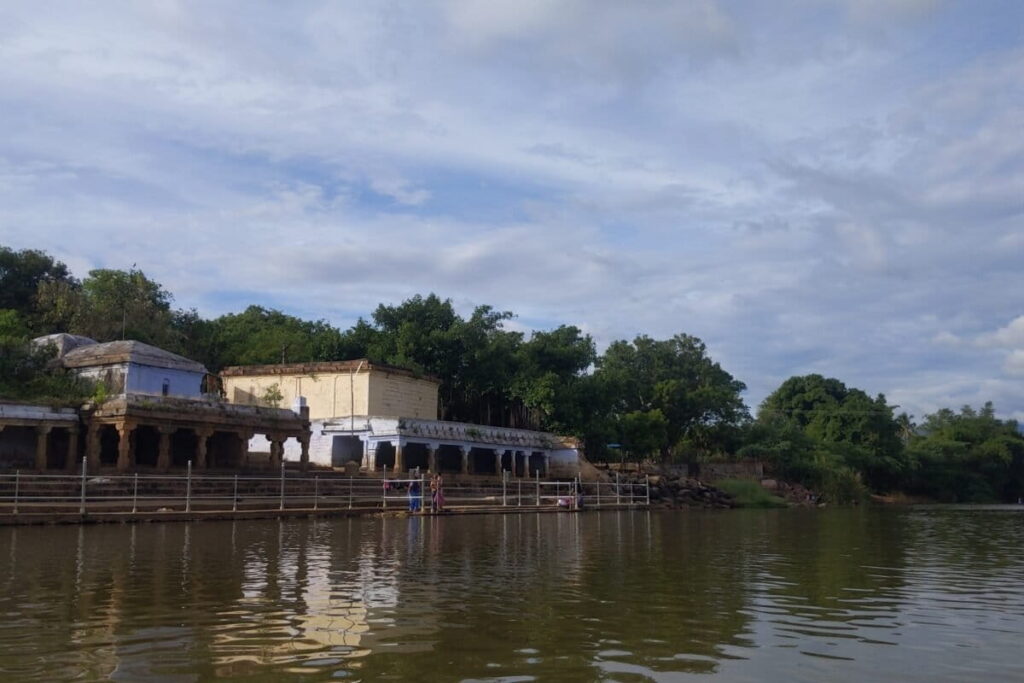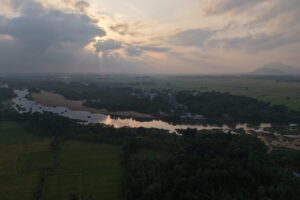This Village In TN Shows How Community-Led River Restoration Works
Oct 14, 2025 | Pratirodh Bureau
The Padhithurai temple in Thirupudaimaruthur is one of the several temples constructed on the banks the river Thamirabarani. Along its banks, waste from rituals conducted in temples (such as clothes and flowers) are discarded into it (Image by A. Thanigavel)
- Thirupudaimaruthur, on the banks of the river Thamirabarani in Tamil Nadu’s Tirunelveli district, emerged as a model village for using a hyper-local approach for river restoration.
- Waste from rituals in temples are frequently discarded into Thamirabarani. Agricultural runoff carries pesticides into the water and untreated domestic sewage continues to enter the river at several points.
- At Thirupudaimaruthur, the community has adopted a holistic approach to biodiversity conservation, integrating ecological, cultural, and social dimensions, making it a scalable model for community-led river restoration.
In the temple village of Thirupudaimaruthur, in Tirunelveli district, nestled on the banks of the river Thamirabarani, the raja gopurams (main towers) of the 14th century Narambunathar Swamy temple, hold more than religious significance. The intricate murals, carved and painted on these towers, depict the region’s once vibrant riparian landscape. Among these, one can find paintings and wood carvings of otters, which serve as the earliest records of otter presence in the region.

The Thamirabarani river, spans approximately 125 kilometres in length and originates from the Pothigai Hills in the southern Western Ghats. Flowing eastward, it traverses a basin area of about 11,125 square kilometres, crossing diverse ecological zones, from wet evergreen forests to arid rainshadow regions, across the Tirunelveli and Thoothukudi districts of Tamil Nadu, before draining into the Bay of Bengal.
However, concerns about the quality of river water have plagued the basin area in recent times. Along its banks, several temples are located, and the waste from rituals, such as clothes, flowers and other offerings, are frequently discarded into the river. This practice, prevalent at certain temple sites, has been gradually spreading to other riverbank shrines. Agricultural runoff from intensively cultivated fields further elevates the nutrient and pesticide load in the water, and untreated domestic sewage continues to enter the river at several points.
Although the Tamil Nadu government has installed decentralised wastewater treatment systems (DEWATS) at multiple locations, their capacity and maintenance remain insufficient. Moreover, the growing footprint of urban and peri-urban settlements along the river’s course further deepens pollution pressures, threatening both water quality and the river’s ecological integrity.
In order to address these concerns, the Tirunelveli District Administration, in 2021, commissioned Ashoka Trust for Research on Ecology and the Environment (ATREE), in collaboration with its knowledge partners, Centre for DEWATS Dissemination (CCD) and the Indian Institute for Human Settlements (IIHS), to develop a Detailed Project Report (DPR) for the restoration of the Thamirabarani river. The plan envisioned a bottom-up, hyper-local approach anchored in community engagement, with operational support from the district administration at the river basin scale.
Understanding ecological processes is closely intertwined with social systems, the Social-Ecological Systems (SES) framework, a ’human-in-nature’ approach, where the social and the ecological are not separate but linked to each other, was explored in the project. Within this framework, the Social-Ecological Observatory (SEO), a research platform that observes ecological systems with social and institutional dimensions to support adaptive management, emerged as a valuable tool to guide this effort. As the project was envisioned to be community-managed in the long run, the observatory intended to foster local stewardship, continuous monitoring, and participatory decision-making.
While grappling with how to operationalise the framework and identify a suitable SEO site, Thirupudaimaruthur emerged as a promising location. The site not only provided a conducive context for piloting restoration activities, but its existing practices also served as a model that could inform and inspire interventions at other locations along the river.
Community stewardship for collective action
Come the Tamil month of Thai (between mid-January and mid-February), one cannot miss the vibrant cacophony rising from within the premises of the temples in Thirupudaimaruthur. The source of this soundscape is the nesting colony of painted storks and spot-billed pelicans, both trying to feed their chicks perched high among the cluster of trees. Another set of birds arrives from the river, some bearing fish for their chicks, while the late breeders return with twigs, busy constructing nests in preparation for the next wave of life.
On the other side of the teppakulam or the temple tank, a different rhythm of life unfolds. Here, it is not the clamour of wetland birds but a sharp call that draws attention to a colony of flying foxes (fruit bats) hanging from the branches. However, coexisting with these beings brings the strong stench rising from the pungent mix of guano and discarded fish parts dropped during the feeding process.
But it raised compelling questions: Why were the bats, once vilified during the COVID-19 pandemic, still accepted here? And what explains the community’s continued tolerance of the overwhelming stench of the bird guano?
It began with the unwavering resolve of M. Narambunathan, affectionately called Narambu anna, who had seen this heronry since his childhood and started treating the young chicks that fell from the towering heights of the tall trees. He shouldered the difficult task of warding off poachers within his community, often confronting them directly to protect the birds he had grown up with. Moreover, in the late 90s, he, along with others, participated in an afforestation drive to protect the bank from erosion and illegal sand mining. While some considered this a form of ecological mismanagement, it was seen as a necessary compromise. It was considered better to retain at least a portion of the riverbank, even if covered in vegetation, than to lose the sand entirely to extraction.
Narambunathan’s commitment towards the birds and riparian vegetation deeply moved late Shri Rathanvel Pandian, a Supreme Court judge who hailed from the village. This represented a critical shift, signalling an emerging model of community-led stewardship, where local engagement with riverine biodiversity transitioned to active protection and co-existence. Pandian took it upon himself to negotiate with the government, which at the time was exploring potential sites for implementing the newly emerging concept of a Conservation Reserve, a designation aimed at protecting wildlife on lands beyond the direct purview of the Forest Department. He was able to ban sand mining, linking the protection of the river with the survival of the wetland birds.
It took years for the sand mining to stop completely, with the community, knowing the perils, stopping the outsiders from continuing with this practice. Over the years, the community has been central and tenacious in the tree plantation across the sandbank to prevent sand erosion and deter mining. They adopted a phased approach, fencing off certain stretches of the riverbank to allow vegetation to regenerate, while leaving other sections open for cattle access.
A. Thanigaivel, a biodiversity monitoring specialist from ATREE’s Agasthyamalai Community Conservation Centre, working extensively on riparian restoration in the Thamirabarani basin, observed that the initial plantations were not well-suited to the riparian ecosystem. Over time, however, more appropriate native species were introduced, resulting in significant ecological benefits. The current vegetation has emerged as a novel ecosystem for cattle from the village and pastoralists having Thenpandi, the native cattle breed, during the peak summer heat. Moreover, it helps stabilise stream banks and improves water retention, contributing to flood control and the overall resilience of the riverine landscape.
This effort came under the ambit of the Social Forestry Division of the Tamil Nadu Forest Department, which provided support for its further expansion. Narambunathan was later inducted into the Forest Department as a forest watcher, but his tenure was brief. He believes more in community-driven nudges than formal enforcement when it comes to protecting the environment.
The formal presence of the Forest Department brought about significant structural changes in bird protection. Poaching was completely curbed, a rescue centre for injured birds and animals was established, and linkages were formed with the Veterinary Department to provide care and support. Over time, the birds have become habituated to human presence, with many species now nesting closer to habitation. A newer and particularly striking development is the sight of cattle egrets roosting and nesting in brambly vegetation close to the ground, right within the village itself, signalling a subtle yet powerful adaptation in this shared landscape.
A scalable model for river restoration
What qualifies Thirupudaimaruthur as a Social-Ecological Observatory (SEO) is that it ticks the boxes on multiple fronts. The community has adopted a holistic approach to biodiversity conservation, integrating ecological, cultural, and social dimensions. Unlike many other temple sites along the river that have become epicentres of ritual waste and cloth dumping, this village stands apart by actively policing such practices. The deep-rooted association with the sacredness of the river has led many community members to consciously resist the contagious trend that is rapidly spreading along the Thamirabarani.
While Thirupudaimaruthur stands as a model in many respects, it’s important to recognise that each village along the Thamirabarani has its unique socio-ecological-cultural context. These local specificities, or curiosities, shape how communities engage with the river and its ecosystems.
Yet, challenges such as open defecation along the banks, discharge of raw domestic sewage, agricultural runoff, and inadequate solid waste management continue to pose serious threats and need urgent attention. Research has shown that the Influent Biological Diatom Index and Water Quality Index (WQI) indicate meso eutrophic (Moderate-Poor) water conditions.
However, the dedication towards biodiversity holds strong. The residents bear the stench of the bat roosting sites, which intensifies during the breeding season. “Even visitors don’t eat in the house during their stay, but we tolerate it,” says a young woman from the village.
Meanwhile, this learning is applied to other potential Social-Ecological Observatory (SEO) sites identified in the District-level Detailed Project Report (DPR), to scale context-specific, community-driven conservation practices across the basin. These efforts equip the community with ecological knowledge that could support the development of community-based ecotourism. This possibility may offer both recognition and modest compensation for their stewardship.
(Published under Creative Commons from Mongabay India)
